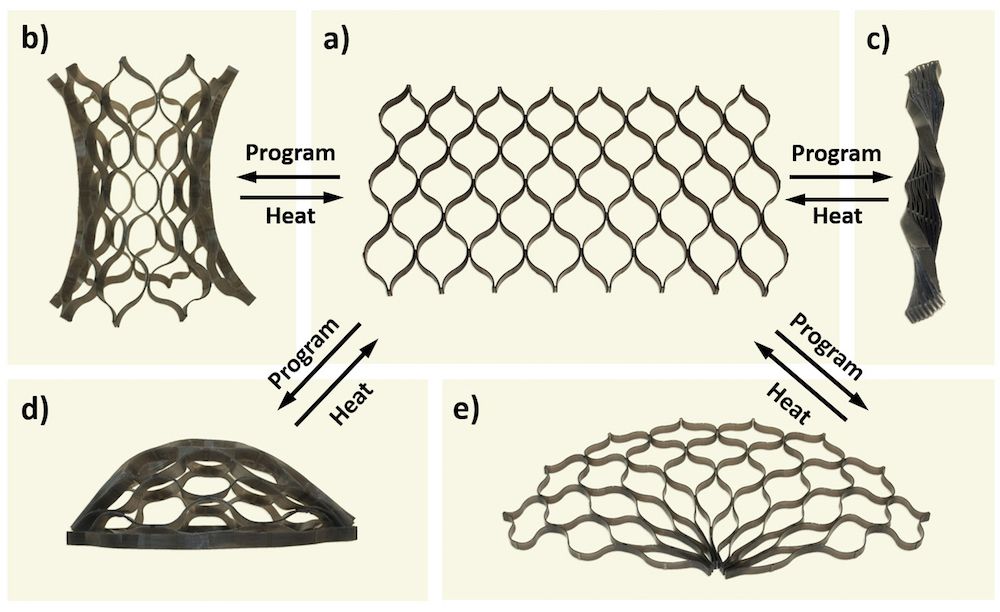Just Add Heat: New 4D-Printed Objects Morph on Cue

Objects that can change shape within seconds after being exposed to heat demonstrate a novel 4D-printing technique that could one day be used to create medical devices that unfurl on their own in the body during surgical procedures.
Engineers created a 3D-printed plastic lattice that quickly expands when submerged in hot water and an artificial flower that can close its petals similar to the way plants do in nature as experiments designed to demonstrate this method of 4D printing.
The new technique significantly simplifies the process of "teaching" 3D-printed materials to change their shape when triggered to do so, said study co-author Jerry Qi, a professor in the George W. Woodruff School of Mechanical Engineering at the Georgia Institute of Technology in Atlanta. [7 Cool Uses of 3D Printing in Medicine]
"Previously, we had to train and program the material after we 3D-printed it," Qi told Live Science. "We had to heat it up and stretch it and then cool it down again for the material to learn the new form. It was relatively tedious. With this new approach, we do all the programming already in the printer."
The researchers are using two types of materials that are carefully combined in the 3D-printed structure to create the desired shape-shifting effect. A soft material holds the energy that drives the shape-change but in the cool state, the energy of the soft polymer is contained by another, glass-like stiff material. This stiff material, however, softens when exposed to heat, allowing the soft polymer to take over. The material is designed to remember the second shape and default to it when it's heated.
"You can heat it up and deform the structure into a new, third shape and it will keep that shape until you heat it up again," Qi said. "Then it transforms back into the second shape."
Previous 4D-printing techniques were able to create materials that change their shape only temporarily, and then after a while, return to the original printed shape.
Sign up for the Live Science daily newsletter now
Get the world’s most fascinating discoveries delivered straight to your inbox.
In the new study, the researchers used a material that changes shape when it is heated to about 122 degrees Fahrenheit (50 degrees Celsius), but Qi said that by engineering the characteristics of the stiff material, the researchers can choose the temperature at which the object transforms.Previous 4D-printing techniques were able to create materials that change their shape only temporarily, and then after a while, return to the original printed shape.
"It promises to enable myriad applications across biomedical devices, 3D electronics and consumer products," said Martin Dunn, a professor of mechanical engineering at Singapore University of Technology and Design, who worked with the Georgia team.
For example electronic components could be printed in the flat form and then once they are assembled into devices, they could "inflate" into their useful 3D shapes.
"It even opens the door to a new paradigm in product design, where components are designed from the onset to inhabit multiple configurations during service," Dunn said in a statement.
Qi thinks biomedical devices such as stents, which are tiny tubes that are used to widen clogged up arteries to prevent strokes, could be created using the technique. These 4D-printed stents would expand inside a blood vessel, automatically triggered just by exposure to the heat of the human body. Currently, surgeons have to inflate the stents with balloons attached to the end of the catheter through which the device is being inserted.
Qi said the new technique is more suitable for practical applications than approaches that rely on hydrogels. The objects described in the new study could transform completely in less than 10 seconds, compared to about 7 minutes required for a hydrogel-based material that was presented a few years ago by a team of researchers from MIT.
Hydrogel-based 4D printing relies on the combination of hydrogels and non-swelling polymer filaments. When immersed in water, the hydrogel swells, forcing the filaments into a new shape.
"In hydrogel-based materials, the shape-change is driven by the absorption of water," Qi said. "But that's a relatively slow process. It takes time, especially if you have large structures."
Engineers from China's Xi'an Jiaotong University also collaborated on the study, which was funded by the U.S. Air Force Office of Scientific Research, the U.S. National Science Foundation and the Singapore National Research Foundation.
The study was published online April 12 in the journal Science Advances.
Original article on Live Science.












